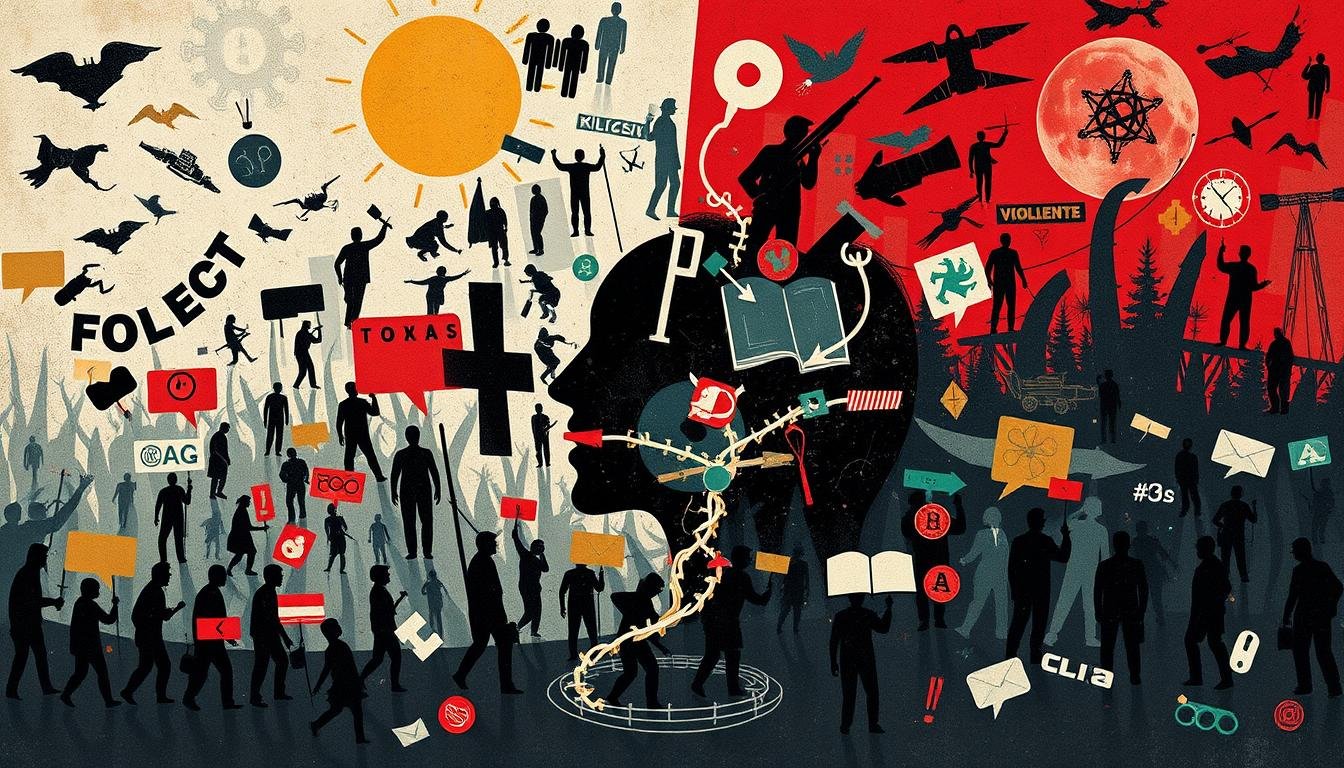Sociological Approaches to Understanding Violence
Violence is all around us, from school fights to global conflicts. Ever wondered why some places see more violence than others? It’s because of the complex social factors that influence our actions.
Sociologists look at violence as a social issue. They help us see the hidden reasons behind conflicts. This way, we can find better ways to stop violence before it starts.
A key study in April 2021 by the European Scholar Journal highlighted a worrying trend. It showed that violence among school kids is on the rise. This calls for urgent action to find the causes and stop it.
One big problem in fighting violence is that we don’t all agree on what it means. Even in places like Uzbekistan, there’s no clear law on violence. This makes it hard to tackle violence effectively.
There are theories that try to explain why violence happens and how it spreads. These theories, like Frustration Theory and Social Learning Theory, are important. They help us understand the roots of violence and how it moves through society.
Key Takeaways
- Violence is a widespread phenomenon that adapts to societal changes
- Lack of clear definitions hinders effective analysis and prevention
- Various forms of violence exist, including physical, mental, and structural
- Social theories provide frameworks for understanding violence’s root causes
- Family, school, and media play crucial roles in learning and perpetuating violence
- Power imbalances within societies often contribute to violent behavior
- Violence can be passed down through generations due to early experiences
Introduction to Violence as a Social Phenomenon
Violence deeply affects our world. It’s key to understand its roots and effects by looking at its social context. Throughout history, people have tried to define and tackle violent acts.
Defining Violence in Social Context
Violence isn’t just about physical harm. It also includes acts meant to hurt others in their minds, wallets, or feelings. Over time, what we see as violent changes with society. For instance, what was once seen as normal in marriage or schools is now widely seen as wrong.
Historical Perspectives on Violence
Looking back at history helps us see how people viewed violence. In the past, some violence was part of society or seen as a personal issue. Now, experts argue if we’re actually more violent or if we just notice and report it more.
The Importance of Studying Violence Sociologically
Studying violence sociologically is crucial to know why it happens more in some places than others. By looking at shared experiences and culture, experts can come up with theories. These theories help in making plans to stop violence and shape policies to make society safer.
“Violence is a socially defined category that involves a victim or group of victims. The social question surrounding violence is why it occurs more in some circumstances than in others.”
Seeing violence through sociology helps us find its deep causes. This way, we can work towards a safer world for everyone.
The Social Construction of Violence
Violence is seen differently in various cultures and times. Scholars like Douglass C. North, John Joseph Wallis, and Barry R. Weingast have greatly helped us understand how societies shape violence. They show how societies define and view violent behaviors.
Culture greatly affects what we see as violent. What’s okay in one place might be seen as violent elsewhere. This shows how violence is not fixed but changes with the culture.
Building a shared understanding of violence comes from our experiences and how we talk about them. Through everyday conversations, we create stories that help us make sense of violence. These stories shape how we see violence in our world.
Then, experts try to put these stories into clear theories. North, Wallis, and Weingast look at how rules and norms affect how we see and act out violence. They teach us to look at violence through the eyes of society, not just our own.
“The social constructionist perspective suggests that crime and deviance are socially constructed concepts that vary across time and cultures.”
This way of seeing violence makes us question what we call violent. It makes us think about who gets to decide what’s violent. By understanding violence as something made by society, we can find better ways to stop it.
Theoretical Frameworks in Sociology for Understanding Violence
Sociological theories give us different views on violence in society. They help us understand why people act violently and how it affects communities.
Functional Analysis
Functional analysis looks at how violence keeps society in order. It says that violence might be needed to stop crime. But, it also makes us think about if violence is right in society.
Conflict Theory
Conflict theory says violence comes from social unfairness. It believes that crime happens because some people are treated unfairly. Places with lots of poverty often see more violence. Fixing these social issues could help lower violence.
Symbolic Interactionism
Symbolic interactionism looks at how we see violence. It shows how culture affects our view of violence. For example, seeing violence in the media can change how we think and act. By looking into this, we can understand why some acts are seen as violent but not others.
| Theory | Key Focus | Example |
|---|---|---|
| Functional Analysis | Social purpose of violence | Law enforcement deterring crime |
| Conflict Theory | Violence as result of inequality | Higher crime rates in poor areas |
| Symbolic Interactionism | Interpretation of violent acts | Media influence on violence perception |
These theories give us deep insights into violence in our society. They help us understand why violence happens and how to stop it.
Sociological Approaches to Understanding Violence
Sociological methods are key in studying violence. They aim to find out why people act violently. Researchers use surveys, interviews, and observations to learn how violence varies among different groups and settings.
Looking closely at violence shows it’s complex. For instance, a study by Land, McCall, & Cohen (1990) showed that homicide rates change a lot in different places and times. This proves that society’s factors matter a lot in understanding violent crimes.
Recent studies highlight how community life affects violence. Armstrong, Katz, & Schenbly (2015) found a link between how people feel about their community and crime rates. They showed that strong community bonds can lower violence.
“The social fabric of a community plays a significant role in shaping patterns of violence and crime.”
Sociologists also look at how violence moves from one generation to the next. Van de Weijer, Bijleveld, & Blokland (2014) found that violence can be passed on in families and groups.
| Study Focus | Key Findings |
|---|---|
| Homicide Rates | Variations across social spaces and time periods |
| Collective Efficacy | Negative correlation with neighborhood violent crime |
| Intergenerational Violence | Evidence of transmission through families and social groups |
By using these methods, researchers are getting a deeper understanding of violence. This knowledge helps us find ways to stop violence before it starts. It’s key for making society safer.
The Role of Social Institutions in Violence
Social institutions shape our lives in many ways, including how violence occurs and is addressed. They help us understand violence better and how to stop it.
Family and Domestic Violence
The family is meant to be a place of love and support. But, it can also be where domestic violence happens. Abuse often goes unnoticed, making it hard to stop. Victims may feel scared to speak up because they fear being judged or not getting help.
Educational Institutions and Violence
Schools are meant to help young people grow and learn. Yet, violence in schools is a big problem. Issues like bullying and fights can happen. These problems come from many things, like peer pressure and societal issues that get into schools.
Media’s Influence on Violence
The media greatly affects how we see violence. News, movies, and video games often show violent acts. Seeing these can make some think violence is normal or fun. It’s important to think carefully about what we watch and hear in the media.
To fight against institutional violence, we must look at how these systems interact. Family life affects kids at school. School shapes how people act as adults. Media influences our views on violence in all parts of life. By understanding these connections, we can work towards a less violent world.
Cultural and Structural Violence
Violence is not just about hitting or hurting people. It also includes cultural and structural violence. These forms shape how we think and act in society. They often go unseen but affect us a lot.
Cultural violence is about beliefs and traditions that make violence okay. It’s part of how we see the world and can lead to more violence. For instance, some believe domestic violence is a family issue, not a crime.
Structural violence is about systems that stop people from getting what they need. It means some don’t have the same chances as others. A study in Baltimore showed how race affects getting HIV treatment, showing structural violence’s impact on health.
Both types of violence are deeply set in our society. Changing them takes time and effort. We must first notice these hidden forms of violence to start making things better.
“Structural violence influences the diagnosis, staging, and treatment of diseases, notably HIV/AIDS, illustrating how social factors affect disease progression and outcomes.”
Seeing how societal norms and violence are connected is key. It helps us find better ways to stop violence and make society fair for everyone.
Interpersonal and Collective Violence from a Sociological Perspective
Violence comes in many forms in our society. It ranges from one-on-one fights to big conflicts. Sociologists study both interpersonal and collective violence to understand their effects.
Individual Aggression vs. Collective Violence
Interpersonal violence is between people. It includes fights, abuse, and murder. In 2011, over 500,000 deaths were from this type of violence.
Collective violence involves groups. It can be about social, political, or economic issues. Both types have different causes.
Personal factors often lead to individual aggression. These can be a history of abuse or substance use. Social learning also plays a role. People may act violently because they see others do it.
Collective violence has its own roots. It often comes from how groups work together and their beliefs. Things like poverty or inequality can spark it. Sometimes, it leads to big conflicts.
Group Dynamics in Violent Behavior
Groups can change how people act in violent situations. People might do things they wouldn’t alone. This is because of group dynamics.
Peer pressure, losing one’s identity, and shared anger can make people more aggressive. Understanding these factors is crucial. It helps us find ways to stop violence. Programs for individuals might not work for group violence. By looking at both types, we can make safer communities.
| Type of Violence | Key Factors | Example |
|---|---|---|
| Interpersonal | Personal history, social learning | Domestic abuse |
| Collective | Group dynamics, shared ideologies | Gang violence |
Social Factors Contributing to Violence
Violence in society comes from many social factors. Poverty, inequality, and lack of education are key to understanding violent behavior. These factors affect different social groups in unique ways, making some more prone to violence.
A study in Hong Kong showed that stress and poor self-control increased violence by 280-299%. In South Africa, 46% of young men in poor areas were more likely to be violent. This links violence to problems with controlling one’s thoughts and actions.
Society also plays a big role in violence rates. In some schools, 36% of classrooms had a culture that led to violence among teens. The community’s environment can greatly affect violence, with some places seeing rates as high as 51.5%.
Economic issues also play a part in violence against women in relationships. Being in a disadvantaged area can lead to more violence, with some places seeing 19.2 incidents per 1,000 women. Gender inequality also matters, with a 42.7% rate of violence in Bolivia.
| Social Factor | Impact on Violence | Prevalence Rate |
|---|---|---|
| Neighborhood Disadvantage | Increased Violence Against Women | 19.2 per 1,000 women |
| Gender Inequality | Higher Intimate Partner Violence | 42.7% |
| Religious Involvement | Decreased Victimization | 37% lower |
Understanding the social roots of violence helps us find ways to stop it. By tackling issues like poverty, inequality, and social exclusion, we can lessen violence in our communities.
Violence Prevention Strategies: A Sociological Approach
Stopping violence needs a wide-ranging plan that looks at many social factors. Studies reveal that different kinds of violence often go hand in hand. This shows we must tackle violence from all angles.
Community-Based Interventions
Community programs are key in stopping violence. They work to make social connections stronger and people more resilient. For example, visiting families in tough areas has been shown to lower the risk of child abuse.
Improving the environment in schools, workplaces, and neighborhoods makes places safer for everyone. This can be done by focusing on the physical and social surroundings.
Policy and Structural Changes
Changing policies is vital to tackle deep-rooted violence issues. Having steady and rewarding jobs helps young people stay away from violence. Sadly, recent policies have hurt vulnerable families, possibly making youth violence worse.
It’s important to give economic chances to young people and families at risk. This can help prevent violence.
Education and Awareness Programs
Teaching and spreading awareness are key to changing how people view violence. These efforts include:
- Conflict resolution training
- Life skills development
- Social-emotional learning
- Safe dating and healthy relationship skills programs
The CDC’s four-level model shows we need to work on violence prevention from many angles at once. By using community programs, policy changes, and education, we can fight violence effectively. This approach targets the deep causes and aims for lasting change.
Challenges in Studying Violence Sociologically
Looking at violence through a sociological lens is tough. One big problem is ignoring domestic and gender-based violence against women in the past. This has left us with incomplete data and a poor grasp of violence in our society.
There are also issues with how we measure violence. The Crime Survey for England and Wales shows that violence is more common than we thought. Police records don’t have clear categories for domestic or gender-based violence, making it hard to collect data.
When researching violence, ethical concerns are key. It’s important to protect both participants and researchers. Getting to certain groups or places can be tough, so careful planning and safety steps are needed.
“The neglect of gendered inter-personal violence is widespread in contemporary social theory, with violence often defined in a way that obscures physical harm from men to women.”
Understanding violence is complex and requires different fields working together. Scholars like Collins, Wieviorka, and Malešević have made big strides in the last ten years. But, there are still debates because different fields see violence in different ways.
| Challenge | Impact |
|---|---|
| Historical neglect of domestic violence | Incomplete understanding of societal violence |
| Lack of specific crime categories | Difficulty in accurate data collection |
| Ethical risks in research | Limited access to certain populations |
| Interdisciplinary nature of violence | Fragmented debates and conceptualizations |
Conclusion
Sociological insights into violence show us its deep roots and how it plays out in society. They tell us how social structures, cultural norms, and institutions affect violent behavior. This helps us understand the complex nature of violence and its wide impact.
Looking ahead, research in this area could be very promising. It could explore how individual actions and societal pressures interact, uncovering new insights into violence. Randall Collins’ research, honored by the American Sociological Association in 2011, sets the stage for new ideas on preventing violence.
For violence prevention, the stakes are high. Sociological views suggest we need to look at both individual actions and societal issues. This might mean changing community programs, laws, and education. By addressing the deep causes of violence, we can aim for safer, more united communities for everyone.
Source Links
- Theories of Violence from a Social Science Perspective – Mobaderoon
- No title found
- No title found
- Violence and Social Orders: A Conceptual Framework for Interpreting Recorded Human History
- The Social Constructionist View of Crime and Deviance
- Sociological Theories of Crime and Deviance | National University
- 1.3 Theoretical Perspectives in Sociology – Introduction to Sociology 3e | OpenStax
- The Sociology of Violence (Chapter 18) – The Cambridge Handbook of Sociology
- Sociocultural Theories of Violence
- Social Justice and Sociological Theory
- Structural Violence and Clinical Medicine
- Structural and social determinants of inequities in violence risk: A review of indicators
- Understanding Violence
- Interpersonal Violence: Global Impact and Paths to Prevention – Injury Prevention and Environmental Health
- Durkheimian Theory of Violence Epidemiology
- Violence Prevention Alliance Approach
- Sociological Theories to Explain Intimate Partner Violence: A Systematic Review and Narrative Synthesis
- Overview and Summary: Societal Violence: What is Our Response?
- About Violence Prevention
- Sociologic perspectives on juvenile violence – PubMed
- Mainstreaming domestic and gender-based violence into sociology and the criminology of violence
- Microsoft Word – IJCV_Editorial_Hartmann_LAYOUT
- 1.2 Sociological Perspectives on Social Problems
- Understanding Aggression in Sociology
- Sociological Perspectives in Family Violence
- Violence







